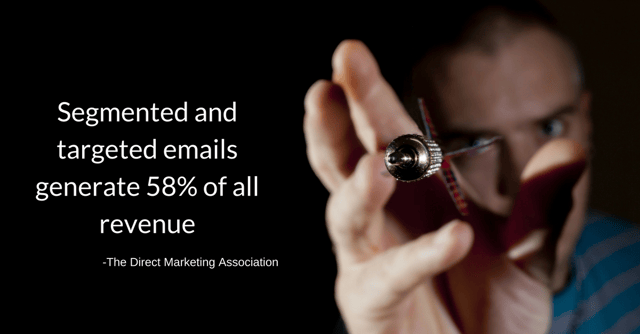.png?width=724&name=Untitled%20design%20(39).png)
As a small business owner, understanding what inbound marketing is and trying to apply it to your existing marketing strategy can be a bit overwhelming. The commitment sometimes intimidates small business owners, but when you embrace the inbound movement, your small business will soon be growing faster than you ever thought possible. It's not just for big businesses. This post will help you break it up into smaller pieces, allowing you to focus on one thing at a time. When it’s all said and done, you’ll have a well cogged machine that works interdependently towards sustainable business growth.
So let’s get started!
The Inbound Breakdown
In order to break it down into more of a manageable strategy, there are 3 things that every inbound marketing strategy must constantly focus on in order to provide the fantastic results business boast about. To be successful with inbound, you must focus on your target audience, your content, and your customers.
Your Target Audiences
You might be wondering why I have both your target audience and your customers as different areas of focus. This is where inbound is different than a traditional marketing approach. It’s looking at who you want to attract, comparing it with who you actually attract, and adapting your efforts to appeal to both. I’ll dive deeper into your customers a little farther down, but first let’s dive deeper into why your target audience is so important.

As a small business owner, you probably have a strong idea of who your ideal customer is. That’s a great start! Inbound calls these people your buyer personas. They’re semi-fictional representations of your ideal customers, but treats them more as a person with a backstory instead of just someone handing you money.
When we take a step back and look at the essence of marketing, it all comes down to targeting. Personas allow you to focus your efforts on specific types of people instead of basic demographic segmentation. It’s essential for small businesses to nail segmentation and targeting down to a science so you can compete with larger competitors.
Understanding who your business exists for is paramount to understanding what to sell, how to sell it, and how to keep them coming back.
Content
Once you have your target audiences established, it’s time to draw them in! It’s no secret that the modern shopper spends their time scouring the web for what they need, so inbound marketing for small businesses focuses on showing up in their research process.
While you can flash paid ads in front of them, these are becoming less effective as time goes on. Shoppers are more informed than ever, and enabling the discovery of valuable information will allow you to capture their attention and ultimately, their wallets. This is done by creating strong content that wins on search engine results pages.
So why is content the second step to setting up your inbound strategy? Whenever you produce a piece of content, the first thing you need to ask yourself is, “who would find value in what I’m about to create?”. If you create content without understanding who it’s for, you’re essentially fishing with a bait-less hook. In other words, people might see it, but they’re not going to see any benefit to exploring it further.
.png?width=640&name=Segmented%20and%20targeted%20emails%20generate%2058%20of%20all%20revenue%20(1).png)
Another reason why your content is so important is for seo purposes. Search engines favor pages with fresh, and higher quality content. Starting a blog for your business is a great way to get started on this right away. In fact, companies who produce 16+ blogs each month see 3 times more organic traffic than those who only post 4.
Content is the medium by which your target audience naturally discovers your brand, and allows them to make purchasing decisions in your favor.
Your Customers
It’s noted that 80% of your business comes from 20% of your customers. Many times, business fail to retain their current customer base by focusing all their efforts on their target audience. This does 2 things:
- Alienates the people who have already chosen to give you their money
- Negatively impacts brand loyalty by creating cognitive dissonance
These are 2 things you can’t afford to do as a small business, so making sure you continue to delight your established customer base is just as, if not more important than focusing your efforts on your target audiences.
You might be thinking to yourself, “But why? They already gave me their money.” This is common, but it’s also a traditional marketing approach. When you look at your customers as a dollar sign instead of a person, you’ll continue to drive them further away from your brand, regardless of how much they “need” your product.
Your current customers are more critical of your business than your target audience. They have the power to go online and post a review. They can post on social media and influence their network’s perception of your business even if they’ve never heard of you. When you stay focused on retaining and strengthening your customer relationships, they’ll become evangelists for your company.

Social proof is a powerful thing. Especially when it comes to marketing to millennials, allowing them ample opportunity to share their opinions about your products or services can do great things for your company. Encourage reviews with incentives and make them public on your site and social media profiles.
This will put your small business on the map and will grow your target audience by increasing brand recognition, an essential aspect to growing a small business.
Data is the Key to Success
Once you have a strong focus on your target audiences, attracting them with quality content, and creating happy customers, the next thing you need to do is look at the data. Data is great, but turning those numbers into impactful information is what allows you to learn and adapt for even more business growth. Here are a few things you can look at to improve the performance of your inbound marketing strategy.
Traffic Data
This is where you’ll dive into your site analytics. How are people finding your site? Where are they coming from? How long do they stay? What do they do once they get there? This information, although anonymous (until they convert), will give you an unbiased look at how people interact with your site.
From this, you can see where you can focus your efforts to make improvements, as well as focus more of your efforts to what is already working well for you. It’s essential that this becomes an ongoing activity for you to maintain an understanding of how the “conversation” is going between your company and the users who arrive on your site.
Key Performance Indicators (KPIs)
Think of your site as your digital store. Whether you sell products directly on it or not, it’s ultimate purpose is to produce revenue for your company. When people arrive on your site, they walk through the front door. Understanding the traffic data your site produces will allow you to measure a few things to gauge the effectiveness of your site and establish an accurate ROI.
Bounce Rate
Ever walk into a store and immediately leave because you knew right away you weren’t going to find anything of value? Follow up question: have you ever gone to a site, and immediately clicked the back button on your browser? This is what digital marketers call a bounce.
Your bounce rate indicates the percentage of people come to your site, and leave without interacting with any of your content. Keeping an eye on this metric will allow you to see how effective you were at setting up your target audiences, and give insight into your overall website aesthetic.
Conversion Rate
On the other hand, the conversion rate measures how many people come to your site and achieve a certain goal. Whether it’s a purchase, subscribing to your newsletter, or filling out a contact us form, the conversion rate measures how well you’ve set up your site to achieve your business goals.
New Users vs Returning Users
This is a great insight to see how your site is doing at attracting new users. It’s a direct measure of business growth, and diving deeper into the conversion rates and bounce rates for both types of users will allow you to get a feel for what people think about your brand. If new users have a high bounce rate, you might want to make the purpose of your site more apparent so they produce higher engagement rates.
Understanding the data and transferring that into impactful information is the key to success for inbound marketing. Without it, you won’t be able to personalize the experience for each user.
Lastly, Be Present
Wherever your target audience and customers interact digitally, you should have somewhat of a presence in order to stay relevant. Post on social media. Send them relevant emails. Create a video blog. Whatever the analytics show they interact with, focus on that and drive up the engagement to establish your brand.
Inbound marketing is all about people. It’s leveraging the personal side of business and fostering the underlying human need for discovery to fuel the growth of your small business. If you need help getting your strategy set up, contact THAT Agency. We're a full service inbound marketing agency and we'll be able to get an in-depth understanding of who you’re trying to attract, and set your small business up for sustainable business growth.





